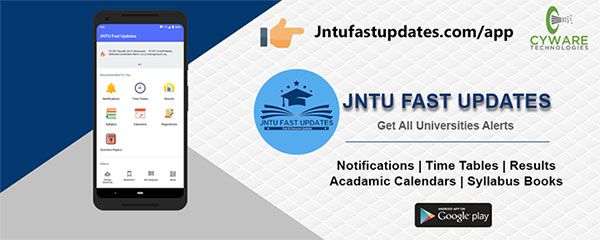JNTUK R16 3-1 Digital Communications Material PDF Download
Students those who are studying JNTUK R16 ECE Branch, Can Download Unit wise R16 3-1 Digital Communications Material/Notes PDFs below.

JNTUK R16 3-1 Digital Communications Material PDF Download
OBJECTIVES:
- Understand different pulse digital modulation techniques and their comparision
- Familiarize various digital modulation techniques and calculation of their error probabilities
- Understand the concept of entropy and different source coding techniques
- Familirize with block codes, cyclic codes and convolutional codes
UNIT-1
PULSE DIGITAL MODULATION: Elements of digital communication systems, advantages of digital communication systems, Elements of PCM: Sampling, Quantization & Coding, Quantization error, Companding in PCM systems. Differential PCM systems (DPCM). Delta modulation, its draw backs, adaptive delta modulation, comparison of PCM and DM systems, noise in PCM and DM systems.
UNIT-2
DIGITAL MODULATION TECHNIQUES: Introduction, ASK, FSK, PSK, DPSK, DEPSK, QPSK, M-ary PSK, ASK, FSK, similarity of BFSK and BPSK.
UNIT-3
DATA TRANSMISSION : Base band signal receiver, probability of error, the optimum filter, matched filter, probability of error using matched filter, coherent reception, non-coherent detection of FSK, calculation of error probability of ASK, BPSK, BFSK,QPSK.
Download UNIT-3 Material PDF | Reference-2
UNIT-4
INFORMATION THEORY: Discrete messages, concept of amount of information and its properties. Average information, Entropy and its properties. Information rate, Mutual information and its properties.
Download UNIT-4 Material PDF | Reference-2
UNIT-5
SOURCE CODING: Introductions, Advantages, Shannon’s theorem, Shanon-Fano coding, Huffman coding, efficiency calculations, channel capacity of discrete and analog Channels, capacity of a Gaussian channel, bandwidth –S/N trade off.
Download UNIT-5 Material PDF | Reference-2
UNIT-6
LINEAR BLOCK CODES: Introduction, Matrix description of Linear Block codes, Error detection and error correction capabilities of Linear block codes, Hamming codes, Binary cyclic codes, Algebraic structure, encoding, syndrome calculation, BCH Codes. CONVOLUTION CODES: Introduction, encoding of convolution codes, time domain approach, transform domain approach. Graphical approach: state, tree and trellis diagram decoding using Viterbi algorithm.
Download UNIT-6 Material PDF | Reference-2
TEXT BOOKS:
- Digital communications – Simon Haykin, John Wiley, 2005
- Principles of Communication Systems – H. Taub and D. Schilling, TMH, 2003
REFERENCE BOOKS:
- Digital and Analog Communication Systems – Sam Shanmugam, John Wiley, 2005.
- Digital Communications – John Proakis, TMH, 1983. Communication Systems Analog & Digital – Singh &
Sapre, TMH, 2004. - Modern Analog and Digital Communication – B.P.Lathi, Oxford reprint, 3rd edition, 2004.
OUTCOMES:
- Determine the performance of different waveform coding techniques for the generation and digital representation of the signals.
- Determine the probability of error for various digital modulation schemes
- Analyze different source coding techniques
- Compute and analyze different error control coding schemes for the reliable transmission of digital information over the channel.


320-x100(1).gif)
